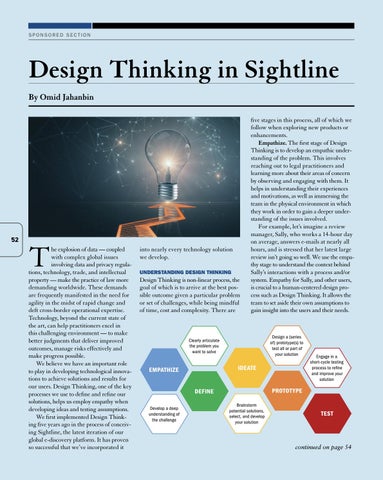SPONSORED SECTION
Design Thinking in Sightline By Omid Jahanbin
52
T
he explosion of data — coupled with complex global issues involving data and privacy regulations, technology, trade, and intellectual property — make the practice of law more demanding worldwide. These demands are frequently manifested in the need for agility in the midst of rapid change and deft cross-border operational expertise. Technology, beyond the current state of the art, can help practitioners excel in this challenging environment — to make better judgments that deliver improved outcomes, manage risks effectively and make progress possible. We believe we have an important role to play in developing technological innovations to achieve solutions and results for our users. Design Thinking, one of the key processes we use to define and refine our solutions, helps us employ empathy when developing ideas and testing assumptions. We first implemented Design Thinking five years ago in the process of conceiving Sightline, the latest iteration of our global e-discovery platform. It has proven so successful that we’ve incorporated it
into nearly every technology solution we develop. UNDERSTANDING DESIGN THINKING
Design Thinking is non-linear process, the goal of which is to arrive at the best possible outcome given a particular problem or set of challenges, while being mindful of time, cost and complexity. There are
five stages in this process, all of which we follow when exploring new products or enhancements. Empathize. The first stage of Design Thinking is to develop an empathic understanding of the problem. This involves reaching out to legal practitioners and learning more about their areas of concern by observing and engaging with them. It helps in understanding their experiences and motivations, as well as immersing the team in the physical environment in which they work in order to gain a deeper understanding of the issues involved. For example, let’s imagine a review manager, Sally, who works a 14-hour day on average, answers e-mails at nearly all hours, and is stressed that her latest large review isn’t going so well. We use the empathy stage to understand the context behind Sally’s interactions with a process and/or system. Empathy for Sally, and other users, is crucial to a human-centered design process such as Design Thinking. It allows the team to set aside their own assumptions to gain insight into the users and their needs.
Design a (series of) prototype(s) to test all or part of your solution
Clearly articulate the problem you want to solve
IDEATE
EMPATHIZE
PROTOTYPE
DEFINE Develop a deep understanding of the challenge
Engage in a short-cycle testing process to refine and improve your solution
Brainstorm potential solutions, select, and develop your solution
TEST
continued on page 54
